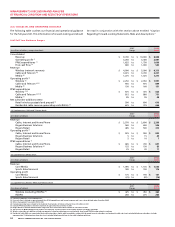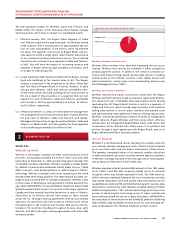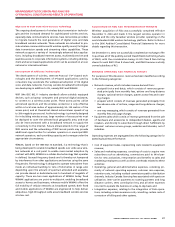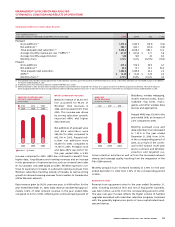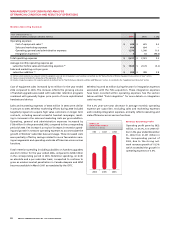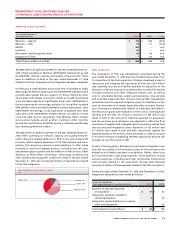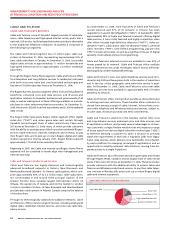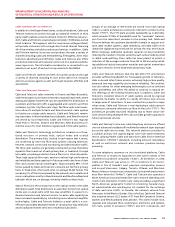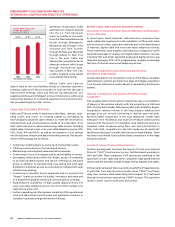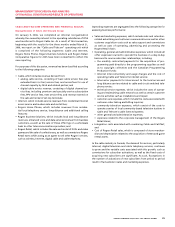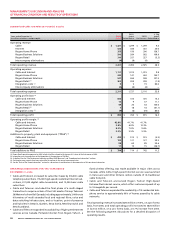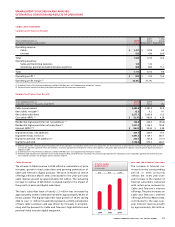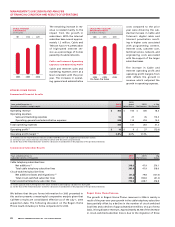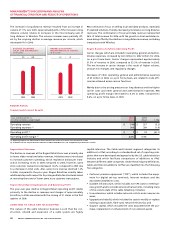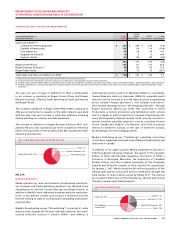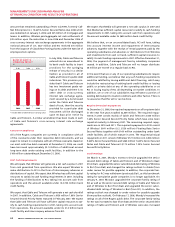Rogers 2006 Annual Report Download - page 38
Download and view the complete annual report
Please find page 38 of the 2006 Rogers annual report below. You can navigate through the pages in the report by either clicking on the pages listed below, or by using the keyword search tool below to find specific information within the annual report.
34 ROG ERS CO MMU NICAT ION S IN C . 20 0 6 ANN UA L RE POR T
MANAGEMENT’S DISCUSSION AND ANALYSIS
OF FINANCIAL CONDITION AND RESULTS OF OPERATIONS
switching infrastructure. Cable
and Telecom’s network extends
into the U.S. from Vancouver
south to Seattle in the west,
from the Manitoba-Minnesota
border, through Minneapolis,
Milwaukee and Chicago in the
mid-west and from Toronto
through Buffalo and Montreal
through Albany to New York
City in the east. Cable and
Telecom has connected its North
American network with Europe
through international gate-
way switches in New York City,
London, England, and a leased
trans-Atlantic fibre facility.
Where Cable and Telecom
doesn’t have its own local facilities directly to a business customer’s
premises, Cable and Telecom provides its local services through a
hybrid carrier strategy. Cable and Telecom has deployed its own
scalable switching and intelligent services infrastructure while using
connections between its co-located equipment and customer prem-
ises, provided largely by other carriers.
CABLE AND TELECOM’S STRATEGY
Cable and Telecom seeks to maximize subscribers, revenue, oper-
ating profit, and return on invested capital by leveraging its
technologically advanced cable network to meet the information,
entertainment and communications needs of its subscribers, from
basic cable television to advanced two-way cable services, including
digital cable, Internet access, voice-over-cable telephony service, PPV,
VOD, SVOD, PVR and HDTV, as well as the expansion of its services
into the business telecom and data networking market. The key ele-
ments of the strategy are as follows:
• Clustering of cable systems in and around metropolitan areas;
• Offering a wide selection of products and services;
• Maintaining technologically advanced cable networks;
• Continuing to focus on increased quality and reliability of service;
• Leveraging relationships within the Rogers group of companies
to provide bundled product and service offerings at attractive
prices, in addition to implementing cross-selling and joint sales
distribution initiatives as well as cost-reduction initiatives through
infrastructure sharing;
• Continuing to develop brand awareness and to promote the
“Rogers” brand as a symbol of quality, innovation and value and
of a diversified Canadian media and communications company;
• Expanding the availability of high-quality digital primary line
voice-over-cable telephony service into most of the markets in its
cable service areas; and
• Further expanding into the business market by offering enhanced
voice and data services and IP access and application solutions to
Canadian businesses and governments of all sizes.
RECENT CABLE AND TELECOM INDUSTRY TRENDS
Investment in Im proved C able Television Networks and Expanded
Ser vice O f ferings
In recent years, North American cable television companies have
made substantial investments in the installation of fibre-optic cable
and electronics in their respective networks and in the development
of Internet, digital cable and voice-over-cable telephony services.
These investments have enabled cable television companies to offer
expanded packages of analog and digital cable television services,
including VOD and SVOD; expanded analog and digital services, pay
television packages, PVR, HDTV programming, multiple increasingly
fast tiers of Internet services and telephony services.
Inc reased Competition from Alternative Broadcasting
Distribution Undertakings
As fully described in the Competition section of this MD&A, Canadian
cable television systems generally face legal and illegal competition
from several alternative multi-channel broadcasting distribution
systems.
Ind ustry Consolidation and Grow th of Facilities-Based
Com petitors
The Canadian telecommunications industry has seen a consolidation
of players in the wireline industry with the acquisitions in 2004 and
2005 of GT by Bell Canada, Allstream by MTS and Call-Net by Rogers.
Competition remains intense in the long distance markets with
average price per minute continuing to decline year-over-year.
Facilities-based competitors in the local telephone market have
emerged in the residential and small and medium-sized business
markets with the launch of competitive local telephone service by
Canadian cable companies using their own last mile facilities in
2005. Until 2005, competitors to the ILECs made use of resold ILEC
facilities and services to provide retail service in these markets. There
has been very limited local facilities-based competition in the large
enterprise market.
Growth of Internet Protocol Based Ser vices
Another development has been the launch of Voice-over-Internet
Protocol (“VoIP”) local services by non facilities-based providers in
2005 and 2006. These companies’ VoIP services are marketed to the
subscribers of ILEC, cable and other companies’ high-speed Internet
services and the providers include Vonage, Primus, Babytel, and others.
In the enterprise market, there is a continuing shift to IP-based services,
in particular from asynchronous transfer mode (“ATM”) and frame
relay (two common data networking technologies) to IP delivered
through virtual private networking (“VPN”) services. This transition
results in lower costs for both users and carriers.
20062005
Pro forma
2004
Pro forma
$3,201$2,925$2,764
CABLE AND TELECOM
TOTAL REVENUE
(In millions of dollars)


